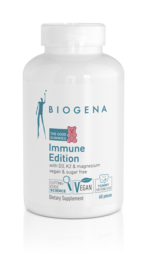HOW THE IMMUNE SYSTEM LEARNS LESSONS FROM DAMAGE AND WHAT ROLE MICRONUTRIENTS PLAY
What do a child’s immune system and children have in common? Both still have a lot to learn. While children explore the world in a playful way and collect sticks and stones, the child’s defence system explores its microbial environment and earns its battle scars in this way. To ensure that both spring chickens are well prepared for the adventures of life, micronutrients provide important aids to protection.
Autumn time = immunity time – especially for children!
When the first cool breezes blow over sun-kissed noses, this is a sign that it will soon be time to say goodbye to hot, bright days flooded with light. With the colder temperatures, not only do light summer clothes go to the back of the wardrobe, but the topic of defence comes increasingly to the fore. Parents in particular are not only concerned with their own immune system, but also with that of their children. After all, the child’s defence system is still developing and is challenged not only by the change in seasons, but also by social contacts in schools, kindergartens, etc.
Childhood years: the immune system is also learning and maturing
When a baby first sees the light of the world, its immune system is still in its infancy. Although this new mortal has an innate immune response that can detect and destroy unwanted and non-specific intruders, the specific immune defense – a further powerful immune system – must first mature over the course of the first ten years of life. So while children are exploring their environment with curiosity and carrying home a few “trophies” with them, the child’s immune system is collecting fighting experience and learning to differentiate between harmless microorganisms and those that need combatting.
The specific immune defence – the special unit of the body police
In order to be able to fight a pathogen with specific agents, the immune system must have come into contact with the attacker before. This is the only way it can “learn from damage” – by committing the intruder to memory. If the body police come into contact with the attacker again, certain special units (lymphocytes) are alerted, antibodies are produced and the germ is destroyed quickly and in a targeted manner. Around the 10th year of life, the immune system has survived its toughest phase in its education; it knows the most common microbial threats in its environment and has developed into an elite fighter.
The intestine: an important immune organ – also in children
The intestine is an important actor in our immune network from childhood onwards. In order to dispel unwanted guests, it draws on a sophisticated three-layer defence system: the intestinal mucosa, the intestinal flora and the intestinal associated immune system (GALT – gut-associated lymphoid tissue). The latter impresses with unimaginable numbers: For example, 70% of all immune cells are located in the small and large intestines and just under 80% of our immune responses occur here. In addition, our 100 billion strong intestinal flora forms a bulwark against harmful intruders and trains our immune cells for life.
Intestinal care starts in childhood
It is therefore all the more important to keep the intestines and its inhabitants healthy during childhood days in particular. This is best achieved with a healthy and varied diet. Our little residents, the intestinal bacteria, enjoy soluble fibre in particular (e.g. from linseed, psyllium seeds, chicory, apples, citrus fruits, etc.).
Tips for a fit child’s immune system
A well-functioning, powerful protection system is the best defence. In this sense, children are well equipped with the following tips:
- Eat a rainbow. In order for the child’s immune system to develop its natural full capacity, it must be "washed" with all the nutrients of a healthy diet. Balanced nutrition rich in vital substances forms the best basis for this. Parents are primarily in the firing line when it comes to eating. The following applies: If you choose fresh and colourful foods and choose seasonal and regional products, your will be serving your family a healthy portion of vitamins and minerals.
- Fill up with the sun vitamin. Vitamin D is an important immune nutrient that provides protection for the child’s immune system. It contributes to the normal functioning of the immune system in children. While vitamin D supplementation is officially recommended for babies until their second spring, parents (after consulting a paediatrician) should ensure that their older offspring are also benefitting from an adequate vitamin D supply. You can find out more about the subject of children, babies and vitamin D here.
- Allow yourself time for day-dreaming. Stress damages the immune system. This applies to young and old alike. After the family has indulged in a welcome short break in the summer, the well-known treadmill starts once again in the autumn. It is therefore all the more important that children are treated to rest breaks in which they do not have to follow any programme and are allowed to simply be a child.
- Take a breath of fresh air. Confirmed couch potatoes will probably object that children only get colds by going outside in the cold and damp season. In fact, just the opposite is true! Exercising in nature not only relieves stress, it also stimulates the cardiovascular system and blood circulation, promotes a good mood and healthy sleep. All of these effects are conducive to a healthy immune system. Therefore: Wrap them all up warmly and pack them off outside!
- Hands off germs. Although sneezing and coughing were long believed to be the worst spreaders of infection, it is now known that cold viruses are usually passed on via the hands. Correspondingly, handles of doors and offices are underestimated sources of infection. And since children often like to put their fingers in their mouths, cold viruses have an easy time of it. For this reason, regular thorough hand washing should be a matter of course for every child.
- But also: Beware of sterility. Hygiene is important, that goes without saying. However, the maturating immune system must be given the opportunity to gain battle experience. Excessive cleanliness undermines the child’s immune system and thus reduces its immune cells. Children who grow up on a farm are only at half the risk of developing hay fever or asthma compared with other children. Therefore the following applies: Let young children play in the garden, in soil, puddles and the like – both the child and its immune system will have hours of fun with this.
- Sufficient liquid. To keep the mucous membranes moist, you should make sure that your child drinks enough throughout the day, preferably water.
PRODUCT TIP
Do you already know our children's products Junior Vitamin D3 and Junior Multi Bo® 13?
Literature with the author.











